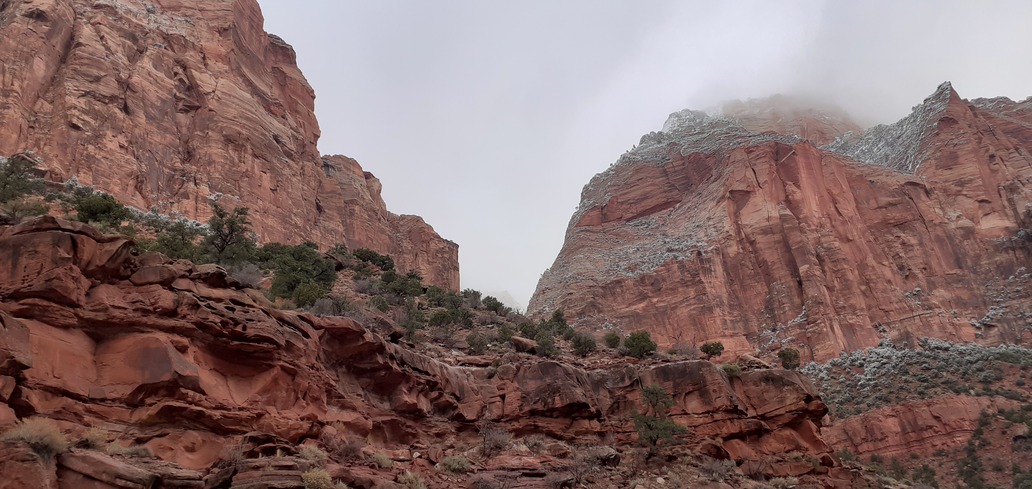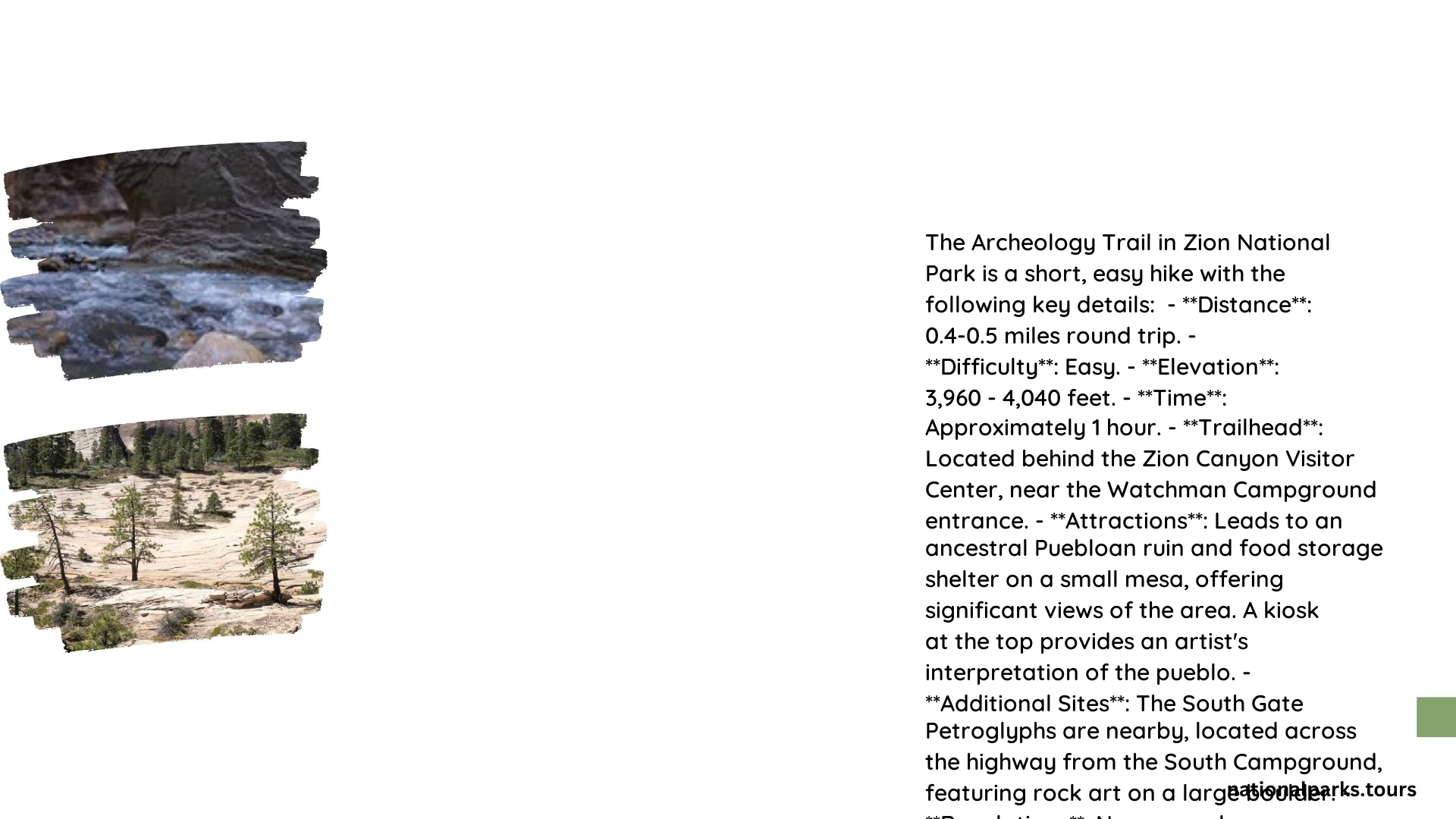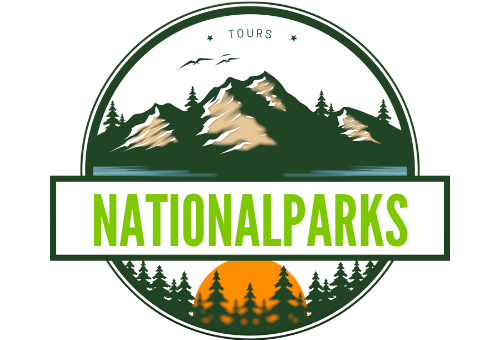The Zion National Park Archeology Trail is a short, accessible hike near the Zion Canyon Visitor Center. This 0.4-mile round-trip trail offers a unique glimpse into the ancient history of the area, showcasing remnants of Ancestral Puebloan civilization. With an elevation gain of about 80 feet, the trail leads to a small mesa where visitors can observe stone foundations of structures dating back to AD 700-950. The site’s historical significance and stunning views make it a must-visit attraction for history enthusiasts and casual hikers alike.
What is the Location and Length of the Archeology Trail?

The Archeology Trail is conveniently located near the Zion Canyon Visitor Center in Zion National Park. Here are the key details:
- Trailhead: Northeast corner of the visitor center parking lot, close to Watchman Campground
- Length: Approximately 0.4 to 0.5 miles round-trip
- Elevation Gain: About 75-80 feet
- Difficulty: Easy
This short trail is perfect for visitors looking for a quick yet informative hike that doesn’t require extensive preparation or time commitment.
What Historical Significance Does the Trail Hold?

The Archeology Trail leads to a site of great historical and cultural importance:
- Time Period: Occupied by Ancestral Puebloans between AD 700 and 950
- Purpose: Likely used for food storage and preparation
- Artifacts: Over 1,600 items discovered, including stone tools and ceramics
- Current Status: Excavated and filled in for protection, but stone foundations remain visible
The site offers a tangible connection to the ancient inhabitants of the area, providing insights into their daily lives and cultural practices.
What Can Visitors Expect to See on the Trail?
While hiking the Archeology Trail, visitors can expect to encounter:
- Stone foundations of ancient buildings
- Panoramic views of Zion Canyon
- Interpretive signs explaining the site’s history
- Natural desert vegetation
It’s important to note that while there are no petroglyphs along this specific trail, the site’s historical significance compensates for this absence.
When is the Best Time to Hike the Archeology Trail?
The Archeology Trail can be enjoyed year-round, but certain times offer optimal experiences:
- Best Time of Day: Sunset for stunning views and reflective atmosphere
- Seasonal Considerations:
- Summer: Early morning or late afternoon to avoid peak heat
- Winter: Midday for warmer temperatures, be cautious of potential snow
- Average Completion Time: 30 minutes to 1 hour
Visitors should always check current weather conditions and park advisories before setting out on the trail.
What Amenities and Regulations Should Hikers Be Aware Of?
To ensure a safe and respectful visit, hikers should be aware of the following:
Amenities:
- Restrooms at the Zion Canyon Visitor Center
- Access to the Zion Human History Museum (to view artifacts found at the site)
Regulations:
- Do not touch or remove any artifacts
- Avoid damaging the site or its surroundings
- Keep the area clean
- No camping or fires near archeological sites
Adhering to these regulations helps preserve the site for future generations and maintains the integrity of the historical area.
How Does the Archeology Trail Compare to Other Zion National Park Hikes?
The Archeology Trail stands out among Zion’s hikes for several reasons:
| Feature | Archeology Trail | Other Zion Hikes |
|---|---|---|
| Length | 0.4-0.5 miles | Varies (up to 16 miles) |
| Difficulty | Easy | Easy to Strenuous |
| Historical Focus | High | Varies |
| Accessibility | Very accessible | Some require permits or special equipment |
| Time Required | 30 min – 1 hour | 1 hour to full day |
This comparison highlights the Archeology Trail’s unique position as a quick, informative hike suitable for a wide range of visitors.
What Should Visitors Bring for the Archeology Trail Hike?
For a comfortable and safe hike on the Archeology Trail, visitors should consider bringing:
- Water (at least 1 liter per person)
- Sun protection (hat, sunscreen, sunglasses)
- Comfortable walking shoes
- Camera for capturing views and site details
- Binoculars for observing distant features
- Light jacket or layers (weather dependent)
- Park map and trail guide
Given the short nature of the trail, extensive hiking gear is not necessary, but proper preparation ensures an enjoyable experience.
How Does the Archeology Trail Contribute to Understanding Zion’s Human History?
The Archeology Trail plays a crucial role in understanding Zion’s human history by:
- Providing tangible evidence of ancient civilizations
- Offering insights into Ancestral Puebloan lifestyles
- Demonstrating the strategic importance of elevated sites
- Connecting visitors to the park’s cultural heritage
- Complementing artifacts displayed at the Zion Human History Museum
This trail serves as an outdoor classroom, allowing visitors to experience history firsthand in its original setting.
What Conservation Efforts are in Place for the Archeology Trail?
To preserve the Archeology Trail and its historical significance, several conservation efforts are in place:
- Site excavation and refilling to protect remaining structures
- Strict regulations against artifact removal or site disturbance
- Interpretive signage to educate visitors about the site’s importance
- Regular monitoring by park staff for any signs of degradation
- Controlled access via a designated trail to minimize impact
These efforts ensure that the site remains intact for future study and enjoyment while allowing current visitors to appreciate its historical value.
By exploring the Zion National Park Archeology Trail, visitors gain a deeper appreciation for the area’s rich cultural history and the diverse experiences offered within the park. This short yet informative hike provides a unique perspective on ancient civilizations, complementing the natural wonders that Zion is renowned for.
References:
1. https://jameskaiser.com/zion/hiking/archeology-trail/
2. https://hike734.com/hikingzion/archeology-trail/
3. https://www.gjhikes.com/2012/10/archeology-trailsouth-gate-petroglyphs.html
